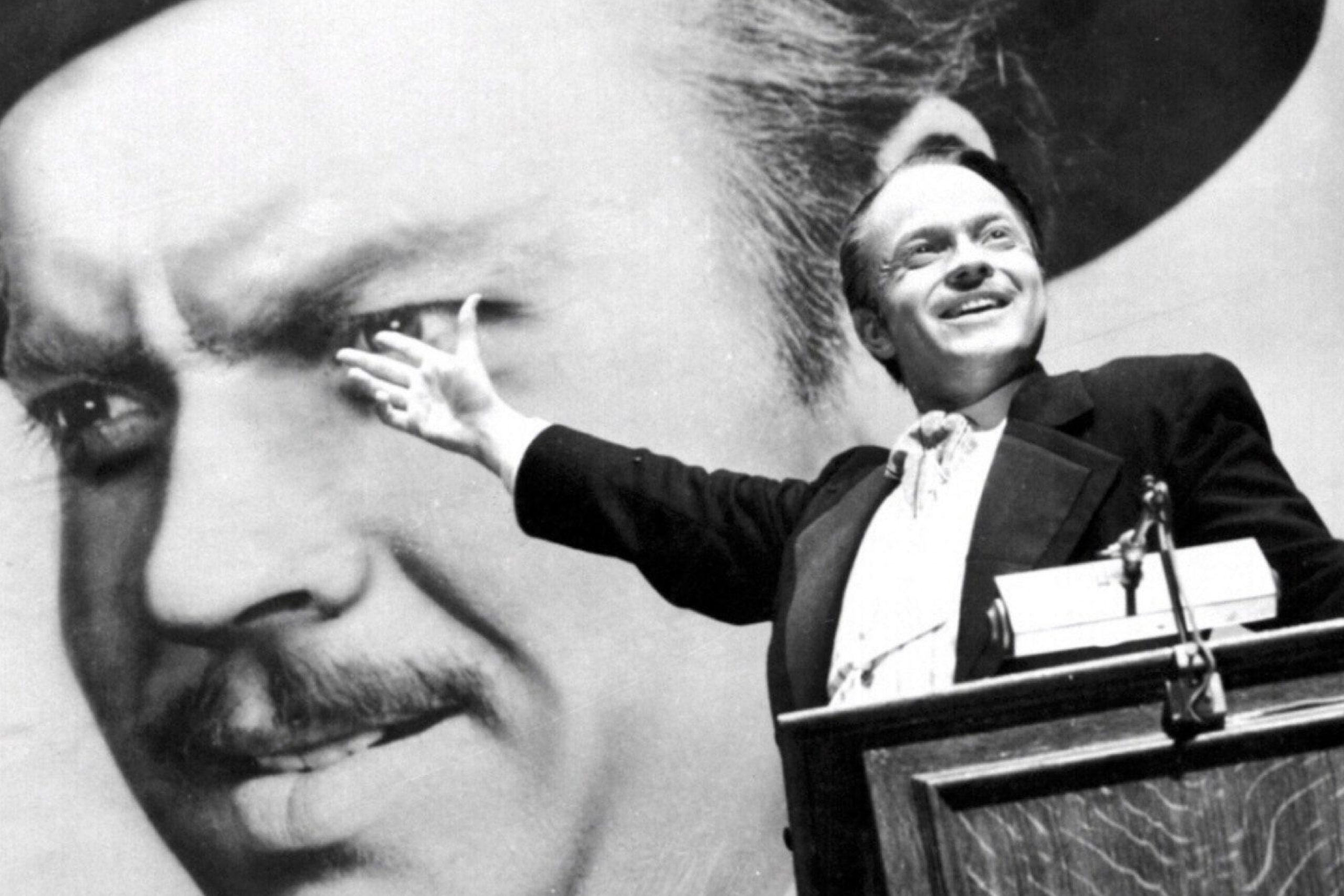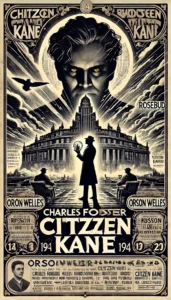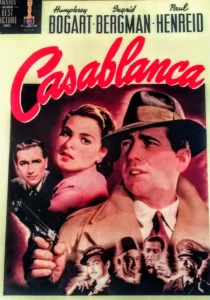
Citizen Kane (1941): : Hollywood Lookup
When Citizen Kane first flickered onto cinema screens in 1941, it wasn’t merely a new release; it was a seismic event that fundamentally reshaped the cinematic landscape.
Directed by and starring the remarkably young Orson Welles, then just 25, the film has rightfully earned its place as a cinematic touchstone, often lauded as the greatest movie ever made.

To approach Citizen Kane is to confront a legend, a film whose technical innovations, intricate narrative structure, and profound exploration of the human condition continue to captivate and inspire more than eight decades later.
This is not simply a movie about a man; it is a meticulous and enduring study of power, ego, and the profound losses that can accompany the relentless pursuit of both.
At the heart of Citizen Kane lies the enigmatic life story of Charles Foster Kane, a media magnate whose trajectory bears striking parallels to that of William Randolph Hearst. The film commences with Kane’s solitary death in his colossal, desolate estate, Xanadu. His dying utterance, the cryptic word “Rosebud,” ignites the film’s central mystery. A cohort of reporters embarks on a quest to decipher its meaning, driven by the belief that this single word holds the key to understanding the complex essence of the man behind the formidable myth.
What unfolds is a compelling series of vignettes, each a memory recounted by individuals who once occupied Kane’s orbit: his guardian, his business associate Mr. Bernstein, his closest friend Jedediah Leland, his first wife, Emily Monroe Norton, and his second wife, Susan Alexander, as well as his butler. Each recollection paints a different facet of Kane’s multifaceted character, gradually revealing his transformation from an idealistic youth to a formidable yet profoundly isolated figure.
The brilliance of the film’s construction lies in its deliberate non-linear approach. Welles, in collaboration with co-writer Herman J. Mankiewicz, eschews a straightforward chronological account, instead presenting Kane’s life as a fragmented mosaic. Each piece, each perspective, offers only a partial and often biased glimpse into his intricate persona. This Rashomon-style storytelling, while more commonplace in contemporary cinema, was revolutionary for its time and paved the way for countless films that would subsequently experiment with narrative chronology. Memory is depicted as fallible, truth as elusive, and identity as something that is often performed rather than inherently fixed.
Orson Welles’s contribution to Citizen Kane is monumental, both in front of and behind the camera. His performance as Kane is nothing short of remarkable, portraying him across a vast expanse of his life, from the initial bloom of youthful charm and unwavering confidence to the decrepit isolation of his final years. His physical transformation is believable and affecting, a testament to the advanced makeup techniques employed for the era.
However, Welles’s true genius arguably resides in his directorial debut. He fearlessly defied conventional Hollywood filmmaking practices, forging a visual and emotional experience that retains a remarkable sense of modernity even today. His collaboration with cinematographer Gregg Toland yielded some of the most iconic and visually arresting imagery in the history of cinema.
Perhaps Citizen Kane‘s most celebrated and enduring contribution to the art of filmmaking is its pioneering use of deep focus cinematography. Toland and Welles masterfully employed wide-angle lenses and innovative lighting techniques to maintain sharp focus across the entire depth of the frame – foreground, midground, and background simultaneously.
This groundbreaking technique allowed for a rich layering of storytelling within a single shot, enabling viewers to absorb multiple pieces of narrative information at once. Furthermore, the film’s inventive use of low-angle shots, often achieved by literally cutting into the studio floor to position the camera, imbued scenes, particularly those featuring Kane at the zenith of his power, with a powerful sense of dominance and grandeur.
The strategic use of shadows throughout the film further enhances its visual storytelling, symbolizing both the enigmatic nature of Kane and the inherent moral ambiguity that permeates his life. Even seemingly simple sequences, such as the montage depicting the disintegration of Kane’s first marriage through a series of increasingly distant breakfast table scenes, showcase Welles’s profound instinct for efficient, elegant, and emotionally devastating visual storytelling.
Beneath its undeniable technical brilliance, Citizen Kane delves into profound explorations of the human condition. The film poignantly examines themes of ambition, loneliness, loss, and the inherent elusiveness of truth. Kane, who initially espouses a commitment to serving the public good through his newspaper, gradually becomes consumed by the intoxicating allure of power. Despite his vast wealth and immense influence, he remains incapable of achieving genuine happiness or meaningful connection. The film serves as a powerful meditation on memory and the subjective nature of identity.
Each character’s recollection of Kane is filtered through their own biases and their unique relationship with him. This inherent subjectivity underscores a haunting truth: the impossibility of ever truly knowing another person. As the reporter muses towards the film’s conclusion, “Maybe Rosebud was something he couldn’t get, or something he lost”.
And then there is “Rosebud” – the enigmatic word that frames the narrative. While its ultimate reveal as the name of Kane’s childhood sled provides a concrete answer, its true meaning remains open to interpretation. For some, it symbolizes the lost innocence of childhood, a time before the corrupting influences of power and wealth.
Others interpret it as a subtle critique of psychoanalytic reductionism, questioning the notion that a single memory or object can fully encapsulate the complexity of a human life. Welles himself famously downplayed its significance, perhaps intentionally leaving its ultimate meaning ambiguous. Its power lies precisely in this ambiguity, serving as a potent symbol of something irretrievably lost. The film’s final image, the burning sled amidst a warehouse of forgotten possessions, is a chilling reminder of the ephemeral nature of material success and the enduring power of lost innocence.
Despite its current critical acclaim, Citizen Kane faced considerable obstacles upon its initial release. William Randolph Hearst, incensed by the perceived parallels between his own life and that of Charles Foster Kane, launched a concerted effort to suppress the film. This campaign included smear tactics and threats against theaters willing to screen it. Consequently, Citizen Kane was not a box office success in its time and only garnered one Academy Award, for Best Original Screenplay.
However, over the ensuing decades, the film’s reputation steadily grew. Scholars and critics increasingly recognized its groundbreaking innovations and profound philosophical depth. For many years, it consistently topped Sight & Sound’s prestigious poll of the greatest films ever made, a testament to its enduring stature within cinematic history.
The influence of Citizen Kane on the subsequent evolution of cinema is immeasurable. Esteemed directors such as Martin Scorsese, Stanley Kubrick, David Fincher, and Christopher Nolan have openly acknowledged its profound impact on their own work. Its innovative storytelling techniques, including the non-linear narrative, unreliable narrators, and layered character studies, have become fundamental elements of modern filmmaking. Furthermore, the film prefigures themes that remain strikingly relevant in contemporary society: the intricate relationship between media and power, the stark contrast between public persona and private reality, and the inherent emptiness that can accompany material success. In an era characterized by billionaires, relentless news cycles, and meticulously curated online identities, Kane’s cautionary tale resonates with a renewed and unsettling potency.
In conclusion, Citizen Kane transcends the label of mere entertainment; it stands as an enduring work of art. Engaging with it is akin to immersing oneself in a great novel, where each frame, every line of dialogue, and every carefully placed shadow offers a new layer of meaning to unpack.
It is a film that rewards multiple viewings, with each encounter revealing fresh depths, posing new questions, and offering deeper insights into the complexities of ambition, love, and loss. For anyone with a passion for cinema, Citizen Kane is not simply recommended viewing; it is essential viewing. Not because it is universally declared “the greatest,” but because it is a film that continues to challenge, inspire, and enthrall audiences more than eighty years after its initial release. Much like the elusive meaning of “Rosebud,” its enduring mystery continues to fascinate and provoke thought. It serves as a timeless reminder of the corrupting nature of ego, the isolating effects of power, and the enduring human yearning for something that often remains just beyond our grasp.
Highlights:
- The film is presented as a “seismic shift in cinematic storytelling and technique,” marking Welles’s directorial debut at the age of 25.
- “Rosebud,” Charles Foster Kane’s final word, serves as the central mystery that propels the film’s narrative. Reporters investigate its meaning, leading to interviews with people from Kane’s past and the piecing together of his life story.
- The film employs a fragmented, non-linear narrative, presenting Kane’s life through the subjective memories of different individuals. This “Rashomon-style” approach challenges the audience to question the reliability of each perspective and form their own understanding of Kane.
- Kane displays idealism and a desire to champion the underdog through his early journalism, making him initially admirable. However, he is deeply flawed by his immense ego, controlling nature, and inability to sustain meaningful relationships, ultimately leading to his isolation.
- Deep-focus cinematography, pioneered by Gregg Toland, keeps all planes of the image in sharp focus, from foreground to background. In Citizen Kane, this technique allows viewers to absorb more visual information within a single shot, enriching the storytelling and creating a more immersive experience.
- Two central themes in Citizen Kane are the corrupting influence of power and the elusive nature of true happiness. Kane’s relentless pursuit of control and material success ultimately leaves him isolated and unfulfilled, suggesting that these external factors cannot replace genuine connection and inner peace.
- The film utilizes overlapping dialogue to create a sense of realism, while echo effects can emphasize loneliness or the lingering impact of the past. The editing, which jumps across time and perspectives, mirrors the way memory functions, contributing to the film’s fragmented yet cohesive narrative.
- The “breakfast table montage” is cited as a prime example of “economical storytelling,” effectively conveying years of marital decline in a short sequence.
- Upon its release, Citizen Kane was met with hostility, largely due to its perceived resemblance to the life of media mogul William Randolph Hearst, who attempted to suppress the film. This led to media blackouts and limited its initial box office success.
- Despite initial controversy and underperformance, Citizen Kane is now considered a masterpiece due to its groundbreaking narrative techniques, visual innovations like deep focus and low-angle shots, and its profound exploration of universal themes like power, identity, and loss. Its influence on subsequent filmmakers and cinematic language is undeniable.
- The burning sled, “Rosebud,” symbolizes the lost innocence and simple happiness of Kane’s childhood, a time before wealth and ambition took over his life. Its destruction represents the ultimate unattainability of that lost self and the emptiness of his later achievements in comparison.
- For more Hollywood lookup: https://thiraimozhinews.com/annie-hall-1977/
Movie Trailer






